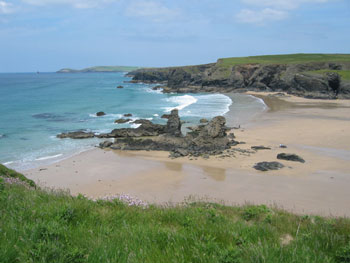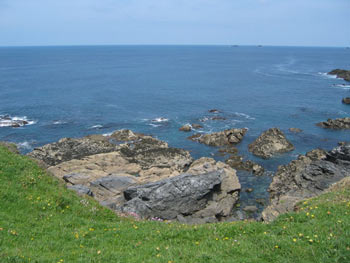Apologies if you have just ‘clicked’ on to this web page expecting to find a detailed list of bass fishing marks for your area. Unfortunately it doesn’t work like that.
Bass are regarded as a much sought after quarry, not only by sport anglers, but also by ‘others’ (both commercial and so-called ‘anglers’, who sell their catch), as a result, bass fishing marks tend to be kept as closely guarded secrets, known only to a few friends. Many bass anglers spend years studying areas and locating good fishing spots, so they tend to be a bit ‘cagey’ about divulging their favourite marks to strangers.
In our view, much of the enjoyment of bass fishing comes from the challenge of discovering places to fish for this wonderful species. There is nothing more satisfying than researching your own bass mark, then enjoying the thrill and satisfaction of catching (and releasing) your first bass from it and subsequently sharing your new mark with friends.

photo – – — a beach with interesting features, try by the rocks — photo courtesy Pete Riley
We hope the following tips will point you in the right direction in your search for bass.
- A lot can be learned by reading about bass. Read the fishing reports and competition results in the media, these will often give you a clue about an area where bass are being caught. All you then have to do is to concentrate on that area to find a suitable mark to fish.
- Visit your local tackle dealer, it is surprising how much information you can ‘glean’ from them, particularly if you spend a few quid!
- The internet is another excellent source of information. The ‘chat’ on the various forums is often very helpful and you can occasionally pick up useful hints concerning fish location, despite the fact that many forum members are wary of giving out too much information.
- Purchase a large scale map of the chosen area, start off by looking for any rivers or streams entering the sea, always a good place to begin. Rocky headlands are also worth investigating , in fact any rocky area, particularly if there are kelp beds, or weedy areas, in the vicinity.
- Once you have decided on the area, walk the beach. Obviously low water is the best time, as all the features will be revealed, but do check the tides first, as you don’t want to get ‘cut off’. Bass like tidal flow, so look for places which create it. Check for rocks, rocky points, loose boulders, sand bars, depressions in the beach, gullies, piers, outflows, jetties, breakwaters, etc., not forgetting weedy areas. Weedy areas are a source of food as many of the creatures that bass seek out for food inhabit weedy areas for protection.
- Bass are a predatory fish and hunt for food, preferring the clearer water to do it. They search out crabs, shrimps, prawns and small fish which all follow the tide in as it covers the beach, rocky outcrops and weedy areas. You will be surprised how little water a bass needs to search out its food, so do NOT discount very shallow water. In fact check it out first, but you need to be careful and ensure your position is not disclosed to the fish. Don’t wade straight out into the sea. Fish the edge first, many large bass have been caught within 2 or 3 yards of the shoreline
- OBSERVATION is the key word. Keep a look out for sea bird activity, gulls, gannets, terns etc., diving into the sea in the same area. They will be feeding on a shoal of baitfish. Beneath the shoal, predatory fish, invariably bass, will be harassing the baitfish and forcing them to the surface. If you can reach, fish the edge of the area of baitfish activity, you have more chance of success there than going for the centre of activity. Spend time looking for bass in calm conditions, particularly at dawn, or dusk. You may see an odd swirl, where a bass has turned, or a spiky dorsal fin sticking out of the water, as the bass ‘grubs ‘ in the shallow water looking for food. Visit the area at different states in the tide. Observe how the marks you saw at low water, now covered, affect the tidal flow. Look for ‘tidal rips’ (where tidal currents meet), bass will patrol these areas waiting for baitfish to be washed towards them.
- REMEMBER, bass are a slow growing species and creatures of habit, they tend to frequent the same area, year after year, so take care of any bass you find. Once a bass is removed it will take many years before a bass of similar size takes over the same patch. NB – to emphasise the point, read the story of ‘Billy’
- FINALLY, why not Join BASS, where you will find other like-minded souls, as well as receive a quarterly magazine giving lots of interesting articles and tips about fishing for and locating bass, but please do not expect to find the magazine containing a published list of marks, for the reasons already stated. However the members are a friendly lot and once you have gained their trust and formed a friendship, you will find members only too willing to assist you.

photo – A few rocks, gullies, weedy, tidal movement, may be worth a go, photo courtesy Pete Riley
We hope you are successful in your quest for bass. Oh! If you do find any good marks, let us know!!!